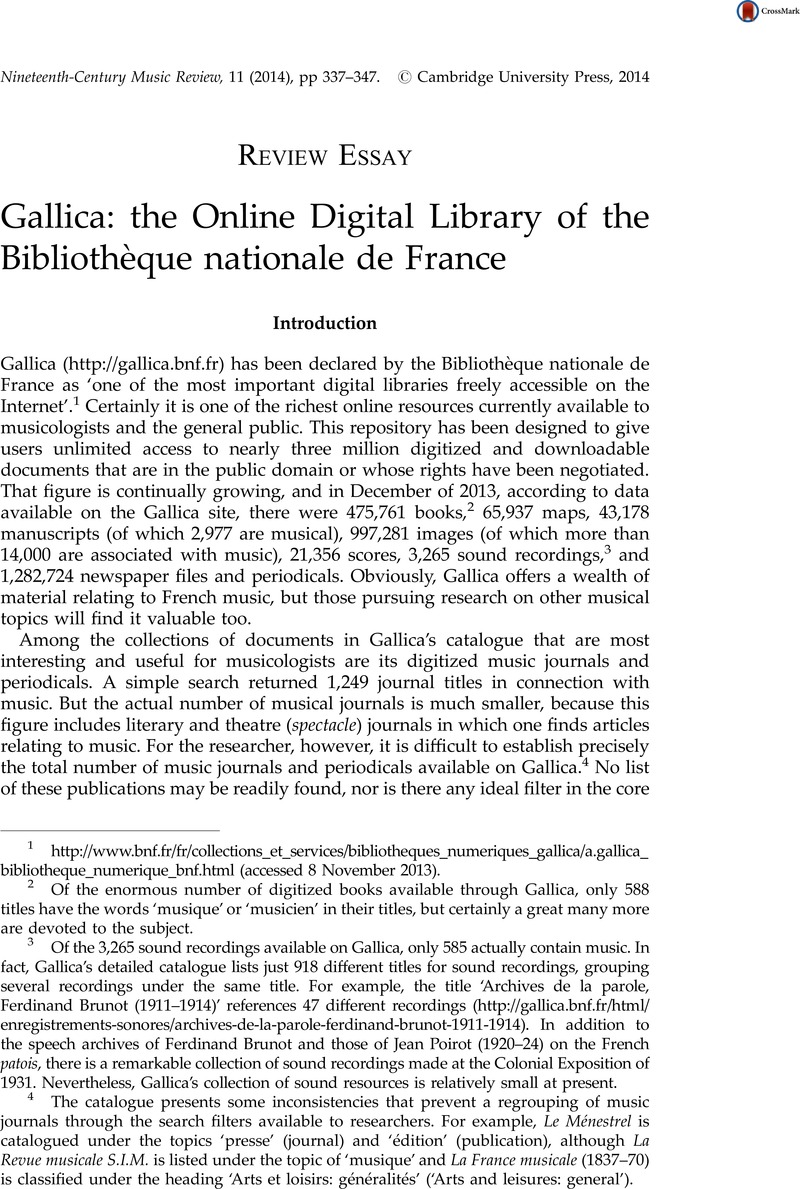Published online by Cambridge University Press: 19 December 2014

1 http://www.bnf.fr/fr/collections_et_services/bibliotheques_numeriques_gallica/a.gallica_bibliotheque_numerique_bnf.html (accessed 8 November 2013).
2 Of the enormous number of digitized books available through Gallica, only 588 titles have the words ‘musique’ or ‘musicien’ in their titles, but certainly a great many more are devoted to the subject.
3 Of the 3,265 sound recordings available on Gallica, only 585 actually contain music. In fact, Gallica's detailed catalogue lists just 918 different titles for sound recordings, grouping several recordings under the same title. For example, the title ‘Archives de la parole, Ferdinand Brunot (1911–1914)’ references 47 different recordings (http://gallica.bnf.fr/html/enregistrements-sonores/archives-de-la-parole-ferdinand-brunot-1911-1914). In addition to the speech archives of Ferdinand Brunot and those of Jean Poirot (1920–24) on the French patois, there is a remarkable collection of sound recordings made at the Colonial Exposition of 1931. Nevertheless, Gallica's collection of sound resources is relatively small at present.
4 The catalogue presents some inconsistencies that prevent a regrouping of music journals through the search filters available to researchers. For example, Le Ménestrel is catalogued under the topics ‘presse’ (journal) and ‘édition’ (publication), although La Revue musicale S.I.M. is listed under the topic of ‘musique’ and La France musicale (1837–70) is classified under the heading ‘Arts et loisirs: généralités’ (‘Arts and leisures: general’).
5 Excluded from selection (see the appended table), are the journals in which the word ‘musical’ appears only in the subtitle. In general, it is oriented more toward journals devoted to art or to literature like La Couronne: journal littéraire et musical (1836) or the original Les Quat'z'arts du Front, Revue bi-mensuelle littéraire, musicale (1916).
6 http://www.bnf.fr/fr/collections_et_services/bibliotheques_numeriques_gallica/a.gallica_bibliotheque_numerique_bnf.html (accessed 8 November 2013).
7 Mission statement of Gallica, downloadable pdf document, 2007, p. 1. http://www.bnf.fr/fr/professionnels/anx_pol_num/a.Charte_documentaire_de_Gallica_1997_2007.html (Accessed 3 December 2013).
8 Gallica's mission statement, p. 2.
9 On the BnF site is a page dedicated to projects in progress: http://www.bnf.fr/fr/professionnels/selectionner_politique_programmes/s.selectionner_programmes_numertisation.html?first_Art=non#SHDC__Attribute_BlocArticle11BnF. Presented there, for example, is the project of digitizing publications of regional learned societies during the nineteenth century.
10 These major dailies often published an illustrated Sunday supplement whose colour cover shows a significant news event. Le Petit journal (1863–1944) published its illustrated between 1884 and 1920. This supplement would go on to become a ‘hebdomadaire’ (weekly periodical) between 1920 and 1937.
11 Pierre Lalo regularly contributed to the musical serial of Le Temps from 1898 to 1914, writing more than 500 articles during this period. After the war, he continued to write for the newspaper, though in an intermittent fashion up until 1940. I thank Martin Guerpin for bringing this information to my attention.
12 The digitized collection of Les Nouvelles littéraires on Gallica is limited to the years 1922 to 1936.
13 Forty-nine volumes of La Revue et Gazette musicale are available on the Archive.org site, however.
14 The collections of manuscripts and autograph letters are not limited to French musicians. For instance, there are some remarkable documents relating to foreign artists, such as the 394 autograph letters of Giuseppe Verdi or the 25 letters of Richard Wagner.
15 Gallica thus gives access to an appreciable number of published popular songs. For example, consider the amusing title ‘A bas le divorce!...’ (‘Down with divorce!...’) composed by Leopold Wenzel (1847–1923?) to words by Baumaine et Blondelet (Paris: P. Feuchot, 1879) and sung by Élise Faure at l'Alcazar d'Hiver (a well-known late-nineteenth century Café-concert establishment in Paris) in the revue ‘Ah! ah! ah!’
16 This is the case, for instance, with the works of Joseph Haydn, Luigi Boccherini and Muzio Clementi.
17 Gallica's interface is available in French, English, German, Spanish and Portuguese, though queries must be submitted in French.